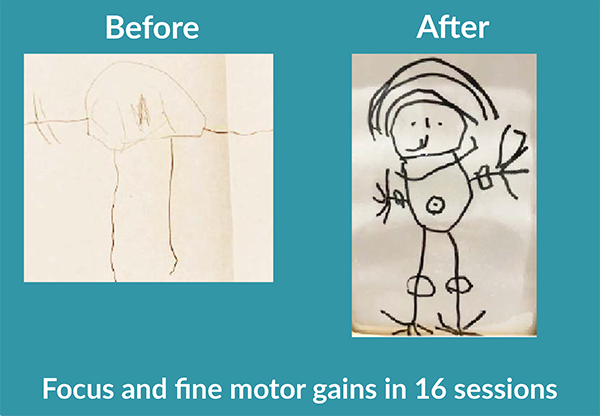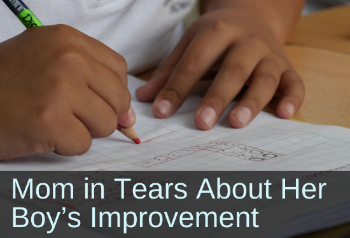The Easy Way to Boost Handwriting and Fine Motor Skills
An important foundational step in the life of a child is the development of fine motor skills and handwriting. The first movements of the hands—grasping, pinching, and finger movements—build the brain and establish the ability for tasks such as feeding, buttoning, shoe-tying, drawing, and writing. Fine motor skills build confidence and independence—they are super important! A lack of gross and fine motor skills is associated with peer victimization (Øksendal et al., 2022) and may affect self-esteem.
Innate infant movements drive the development of gross and fine motor skills (Utley, 2018). When these infant movements are hindered, we often see retained primitive reflexes and, in turn, difficulty with fine motor skills.
Unintegrated primitive reflexes can contribute to fine motor delays and other challenges
 This case study shows how neurodevelopmental movements helped this young girl meet all her OT goals in just 3.5 months, and transition to typical kindergarten without an IEP.When Hand reflexes, such as the Palmar/Babkin and Grasp reflexes, are unintegrated (retained), we often see weak hand muscles, inability to move the thumb and fingers separately, tense pencil grip, hyper-sensitive palms, and lack of dexterity.
This case study shows how neurodevelopmental movements helped this young girl meet all her OT goals in just 3.5 months, and transition to typical kindergarten without an IEP.When Hand reflexes, such as the Palmar/Babkin and Grasp reflexes, are unintegrated (retained), we often see weak hand muscles, inability to move the thumb and fingers separately, tense pencil grip, hyper-sensitive palms, and lack of dexterity.
The hands and mouth are connected by reflexes in infancy. That is why retained hand reflexes are often seen with speech challenges, drooling, movements of the mouth while moving the hands, and tension in the jaw.
Poorly developed hand reflexes can have an impact in the classroom. Richards et al. (2022) state: "Primitive reflex retention may interfere with handwriting development…We found that more children with handwriting difficulties had reflex retention, and reflex retention was associated with handwriting ability, after controlling for vision, implying a likely need to address reflex integration (p. 1)."
Other retained reflexes may also be involved in cases of fine motor deficits. In children (4.6 to 5 years), Callcott (2012) found that 65% of the children had a retained Asymmetrical Tonic Neck Reflex (ATNR) that was significantly associated with poor fine motor skills and delays in school readiness.
Boost Handwriting and Fine Motor Skills the Easy Way with Primitive Reflex Integration
By integrating hand reflexes, children appear to write more easily, clearly, and with less fatigue. Primitive reflex integration was found to be more effective than other methods to impact fine motor skills (Brown (2010). The most likely reason is that the primitive reflexes are the very movements that help us develop the muscles and use of our hands in infancy. They also develop our hand-eye coordination. This suggests that the easy way to help with fine motor skills is to use the natural developmental process—primitive reflex integration—that is already innately wired in humans to promote hand function.
Primitive reflex integration activities targeting the hands, arms, head, and neck appear to be an important key for helping individuals of all ages develop fine motor skills. Besides helping with handwriting, integration of the hand reflexes often helps eliminate hypersensitivities of the palms, and calms the nervous system—a big bonus to help children who fidget.
Innate rhythmic and reflex integration movements make a powerful difference for fine motor skills and handwriting
The innate rhythmic and reflex integration movements are simple yet powerful tools to lay the groundwork for developing the hands, fingers, brain, and sensory systems, leading naturally to improvements in fine motor ability. We often see that even stubborn handwriting challenges can be greatly helped by integrating retained hand reflexes. Integration of the hand reflexes helps the hands to be stronger and more functional. To see how these neurodevelopmental movements can make a powerful difference, check out the success stories here.
Rhythmic movements and primitive reflex integration helped this 6-year-old boy improve many aspects of learning. Key to his dramatic progress was the use of rhythmic movements at home. This case study shows just how profound the effects of neurodevelopmental movements can be!
Constant fidgeting, attention issues, and fine-motor skills were some of the challenges this 5-year-old boy was facing. Find out how his OT introduced rhythmic movements and primitive reflex integration and, over the course of 16 sessions, saw significant improvements with all of these issues.
Here is an example of how a skeptical OT helped her 8-year-old client. This little boy struggled for years with poor handwriting and difficulty attending to structured tasks. See how his OT used neurodevelopmental movements to help him see profound improvements in just 5 sessions.
Help for Handwriting, 3 Fundamentals
Children are often asked to practice handwriting over and over.
But if the foundations for handwriting have not been built, practicing is often stressful and may not produce good results. Handwriting requires building complex, global skills to all work in harmony within the brain, body and sensory systems.
Keep these 3 things in mind for best results to improve handwriting:
1. Foundation—hand & arm muscle strength, motor skills, brain and sensory connections
2. Relaxation
3. Focus
The foundation, relaxation, and focus for improved handwriting can be accomplished by using innate rhythmic and reflex integration movements from the Brain and Sensory Foundations course.
Once these 3 are in place, then practicing makes sense and is much more enjoyable and effective.
Did you know that cursive writing helps boost learning and language development (Ose Askvik et al., 2020)?
Get the tools to help struggling writers succeed.
References
Brown, C. G. (2010). Improving fine motor skills in young children: An intervention study. Educational Psychology in Practice, 26(3), 269-278.
Callcott, D. (2012). Retained primary reflexes in preprimary-aged Indigenous children: The effect on movement ability and school readiness. Australasian Journal of Early Childhood, 37(2), 132–140.
Richards, L., Avery, R., Gray, S., & Price, R. (2022). Relationship of retained primitive reflexes and handwriting difficulty in elementary-age children. The American Journal of Occupational Therapy, 76 (Supplement_1), 7610505010p1.
Øksendal, E., Brandlistuen, R. E., Holte, A., & Wang, M. V. (2022). Associations between poor gross and fine motor skills in pre-school and peer victimization concurrently and longitudinally with follow-up in school age—results from a population-based study. British Journal of Educational Psychology, 92(2), e12464.
Ose Askvik, E., Van der Weel, F. R., & van der Meer, A. L. (2020). The importance of cursive handwriting over typewriting for learning in the classroom: A high-density EEG study of 12-year-old children and young adults. Frontiers in Psychology, 11, 550116.
Sonia Story, MS has been teaching neurodevelopmental movements since 2006.
She is an honors graduate with a Bachelor's degree in biology/psychology and a Master’s degree in Movement Sciences.
Sonia developed the Brain and Sensory Foundations program to provide comprehensive training in neurodevelopmental movements—combining innate rhythmic movements, play, primitive reflexes, and postural reflexes.
She is the author of The Importance of Reflex Integration and the Evidence eBook, giving the rationale and evidence basis for using neurodevelopmental movements for helping with challenges such as ADHD, Sensory Processing Disorders, anxiety, emotional dysregulation, visual skill deficits, poor social skills, gross and fine motor delays and other neurodevelopmental and behavioral disorders.
Her work is featured in numerous podcasts, summits, and conferences, and in the books Almost Autism: Recovering Children from Sensory Processing Disorder; Special Ed Mom Survival Guide; Family Health Revolution; and Same Journey, Different Paths—Stories of Auditory Processing Disorder.
Sonia’s mission is to help children and families experience the profound benefits of neurodevelopmental and integrative movements for more functional and fulfilling lives.





